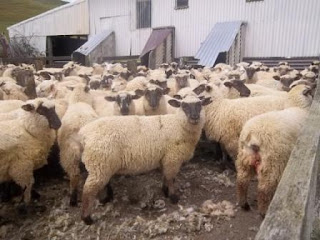 |
| Fridolin crutching away |
 |
| Last of the lambs to be crutched |
 |
| Mal and Fridolin getting through the crutching |
 |
| The lambs at the end |
 |
| Wet hoggets with their full wool emptying out in the yards |
Whilst some had lambed but not reared a lamb, the majority of the hoggets came out of their full wool fleece in good condition. A hint of fly is sneaking into the flock, and a few of these girls, along with the odd lamb, are now being struck. The warm, wet, humid weather is ideal conditions for fly. As all these girls were scanned in lamb, they were identified after shearing with a small age mark near the station mark for future reference.
Then it was onto the black face lambs left (n=296).
 |
| Lambs waiting in the catching pen |
 |
| Shearers and woolhandlers working at it |
 |
| Today's shearers |
 |
| Lambs without their coats |
This afternoon it was onto the white face lambs. This took the shearers till the end of the day (sorry don't have the tally book). Hopefully by lunchtime tomorrow all the shearing will be done. It has been quite patchy in getting it all complete and seems more day than usual.
Hopefully the wool will be picked up sooner rather than later and a cheque in the bank!
Encouraged that shearers and woolhandlers receive training for several reasons:
- shearers learn an good efficient technique which helps them achieve their goal (numbers shorn) and remain in reasonable physical condition.
- shearers don't miss treat the animals or make unneccessary cuts which can be distressing for all.
- shearers reduce the amount of second cuts which decreases the value in wool
- woolhandler is confident in moving the wool around the shed without disrupting the shearer
- that the woolhandler is quick and efficient in separating the wool, at least seconds and main line, and be observant in preparing the main line that it is of similar length and colour (all else is removed). This enables the farmer to maximise their income from the wool.
- Presser to be confident in blending wool (especially second shear and lambs) before it enters the press and undertakes a QA job of removing any missed bits.
- Press capable of pressing a bale of wool and recording it correctly
- Presser aware of shearers and keeps the pens full of sheep.
To find out more about training see http://www.tectra.co.nz/
No comments:
Post a Comment